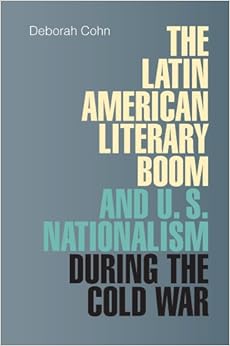A review I wrote of Deborah Cohn's The Latin American Literary Boom and U.S. Nationalism during the Cold War that will appear in the journal The Latin Americanist.
If the search for the great (North)
American novel goes on, the great Latin American novel was thought discovered
in 1970. That was the year that the English translation of Gabriel García
Márquez’s One Hundred Years of Solitude
appeared and became a sensation in the English-speaking world. It was the
second work by a Latin American writer to make the New York Times bestseller list (after Jorge Amado’s Gabriela, Clove and Cinnamon), and it represented
the height of the “boom” in Latin American letters. The literature of the boom
generation, for good and for ill, continues to provide readers from around the
world with metaphors and points of reference for understanding Latin American
politics, society, and history. But, as Deborah Cohn argues in this subtle and
rewarding book, the boom happened neither precisely by accident nor by design.
It was the complex result of multiple factors, including the work of Spanish
publishing houses and literary agents, the solidarity of a small group of
talented Latin American writers, the international appeal of the Cuban
Revolution, and the Cold War politics of institutions and foundations in the
United States.
It is the U.S. Cold War politics of
the boom that are the primary subject of Cohn’s book, and they form a
particularly rich vein for thinking through problems of cultural transmission. Most
of the authors of the boom were resolutely left-wing—sympathizers and defenders
of the Cuban Revolution. García Márquez would be famous for his decades-long
friendship with Fidel Castro. And many of the novels of the boom explored the
decadence of the Latin American bourgeoisie and had clear anti-capitalist
interpretations. Yet U.S.-based foundations and organizations with
anti-revolutionary Cold War outlooks contributed to making the boom possible.
As Cohn writes, “Latin American literature’s circulation in the United States
thus paradoxically benefited from both hegemonic and anti-hegemonic forces—that
is, from endeavors that stemmed from commitments to anti-revolutionary and
revolutionary politics alike.” (4)
To make the argument, Cohn moves
through investigations of a number of institutions that had Cold War agendas at
work in the background but were made into something more complex than that by
their participants. She begins with a description of the McCarran-Walter Act of
1952, which denied visas to foreigners with suspected ties to Communism, a
provision that caused intermittent problems for many Latin American writers. The
subsequent three chapters cover the meeting of International P.E.N. in New York
in 1966, the growth of Latin American literature studies in U.S. universities
in the 1960s, the translations sponsored by grants from the Association of
American University Presses, and the Ford- and Rockefeller-funded Center for
Inter-American Relations (CIAR). The foundations that sponsored these
organizations had Cold War objectives—P.E.N. even received some money from CIA
fronts.
But in all cases, Cohn weaves
complex arguments about the consequences of institutional action, seeing less
capacity for ideological control than previous scholars who have examined related
topics. The P.E.N. meeting, for example, was a key moment for various Latin
American writers, many of them on the left, to meet each other and consolidate
the connections that sustained the “boom” as a community. And the CIAR,
similarly, promoted left-wing writers and perspectives. In Cohn’s words, “Cold
War efforts to neutralize the Communist threat motivated public and private
support for the cultural production of a region of great political interest to
the United States, creating a space for authors associated with the rising tide
of Marxism in Latin America and, by extension, for the expression and
dissemination in their works of the ideology that the state was trying to
eradicate.” (149)
This is an admirably subtle, and,
in my view, convincing argument. But perhaps it is not as surprising as it
first appears: both the Ford and Rockefeller foundations were going through politically
progressive moments in the late 1960s and 1970s, and practiced some
“self-criticism” regarding their sponsorship of earlier “Cold War” projects.
Emir Rodríguez Monegal, who edited the magazine Review for CIAR for a time, was fresh off of the exposure of the
CIA connections of his previous effort—the infamous Mundo Nuevo—and was eager to demonstrate that he had been an
independent socialist all along. And it is not clear that the “boom” literature
would always read to North American audiences as “Marxist”—as Cohn points out,
modernist literary techniques that were widely used by “boom” writers like
Gárcia Márquez were associated with anti-Communist politics in the United
States, though not in Latin America. But Cohn’s book is an important and
rewarding study that should be of interest to scholars from multiple
disciplines, and even to those outside Latin American studies who work on Cold
War institutions. She has succeeded in making the politics of the boom simultaneously
more complex, and more intelligible.

No comments:
Post a Comment